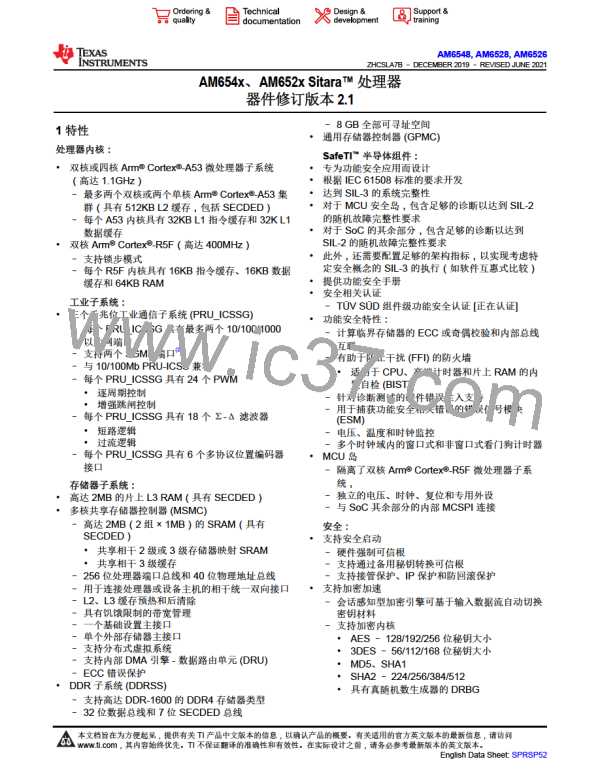AM6548, AM6528, AM6526
ZHCSLA7B –DECEMBER 2019 –REVISED JUNE 2021
www.ti.com.cn
7.7 VPP Specifications for One-Time Programmable (OTP) eFuses
This section specifies the operating conditions required for programming the OTP eFuses and is applicable only
for High-Security Devices.
7.7.1 Recommended Operating Conditions for OTP eFuse Programming
over operating free-air temperature range (unless otherwise noted)
PARAMETER(2)
DESCRIPTION
MIN
NOM
See 节7.4
MAX
UNIT
VDD_MCU
Supply voltage range for the core domain
during OTP operation; OPP NOM (BOOT)
V
VPP_CORE
VPP_MCU
Supply voltage range for the eFuse ROM
domain during normal operation
NC
NC
NC
1.8
V
V
V
V
Supply voltage range for the eFuse ROM
domain during OTP programming(1)
Supply voltage range for the eFuse ROM
domain during normal operation
Supply voltage range for the eFuse ROM
domain during OTP programming(1)
1.71
0
1.89
I(VPP_MCU)
Tj
100
85
mA
°C
Temperature (junction)
25
(1) Supply voltage range includes DC errors and peak-to-peak noise. TI power management solutions TLV70718 from the TLV707x family
meet the supply voltage range needed for VPP_MCU.
(2) NC stands for No Connect.
7.7.2 Hardware Requirements
The following hardware requirements must be met when programming keys in the OTP eFuses:
• The VPP_MCU power supply must be disabled when not programming OTP registers.
• The VPP_MCU power supply must be ramped up after the proper device power-up sequence (for more
details, see 节7.9.2, Power Supply Sequencing).
7.7.3 Programming Sequence
Programming sequence for OTP eFuses:
• Power on the board per the power-up sequencing. No voltage should be applied on the VPP_MCU terminal
during power up and normal operation.
• Load the OTP write software required to program the eFuse (contact your local TI representative for the OTP
software package).
• Apply the voltage on the VPP_MCU terminal according to the specification in 节7.7.1.
• Run the software that programs the OTP registers.
• After validating the content of the OTP registers, remove the voltage from the VPP_MCU terminal.
7.7.4 Impact to Your Hardware Warranty
You accept that e-Fusing the TI Devices with security keys permanently alters them. You acknowledge that the
e-Fuse can fail, for example, due to incorrect or aborted program sequence or if you omit a sequence step.
Further the TI Device may fail to secure boot if the error code correction check fails for the Production Keys or if
the image is not signed and optionally encrypted with the current active Production Keys. These types of
situations will render the TI Device inoperable and TI will be unable to confirm whether the TI Devices conformed
to their specifications prior to the attempted e-Fuse.
CONSEQUENTLY, TI WILL HAVE NO LIABILITY (WARRANTY OR OTHERWISE) FOR ANY TI DEVICES THAT
HAVE BEEN e-FUSED WITH SECURITY KEYS.
Copyright © 2021 Texas Instruments Incorporated
Submit Document Feedback 139
Product Folder Links: AM6548 AM6528 AM6526

 TI [ TEXAS INSTRUMENTS ]
TI [ TEXAS INSTRUMENTS ]